Runway-Free Recovery Methods for Fixed-Wing UAVs: A Comprehensive Review
Abstract
:1. Introduction
2. Search Method
3. Fixed-Wing UAVs Runway-Free Recovery Methods and Applications
3.1. Parachute Recovery
3.1.1. Natural Inflation Opening
3.1.2. Actuator Opening
3.1.3. Tractor Rocket Ejection Opening
3.2. Net Recovery
3.3. Rope Recovery
3.3.1. Horizontal Rope Recovery
- Approach: The UAV is guided to the rear area of the capture rope, and the altitude and heading of the UAV are adjusted to align with the capture rope;
- Pre-recovery: The UAV tracks or aligns with the capture at a preset speed, and the recovery hook on the UAV is lowered, ready to enter the capture phase;
- Capture: If the capture rope successfully intercepts the UAV, the capture is successful. If not, the UAV enters a roundabout route;
- Stow: If the UAV is successfully captured, the UAV can be taken down manually or by a robotic arm and recovered to a designated location, thus completing the entire recovery process.
3.3.2. Vertical Rope Recovery
3.4. SideArm Recovery
3.5. Deep Stall Recovery
3.6. Towed Drogue Docking Recovery
3.6.1. Docking With a Stabilization Docking Drogue
3.6.2. Docking with Foldable Bistable Gripper Trunnion
3.7. Robotic Arm Recovery
3.7.1. Passive Recovery Method of Robotic Arm
3.7.2. Active Recovery Method of Robotic Arm
4. Path Planning and Guidance Technology in the Pre-Recovery Process
4.1. Linear Planning
4.2. LOS Guidance
4.3. Multi-Objective Optimization
4.4. Machine Learning Methods
4.5. Path Planning and Guidance Based on Heuristic Algorithms
5. Position and Attitude Control Methods During the Recovery Process
5.1. Classical Control Algorithms
5.2. Modern Control Algorithms
5.3. Intelligent Control Algorithms
5.4. Predictive Control Algorithms
6. Relative Position Sensor of Recovery
6.1. GNSS
6.2. Visible Light Camera
6.3. IR Camera
6.4. Depth Camera
7. Discussion and Future Research Directions
- Due to the study’s scope, the primary focus is on fixed-wing UAV technologies for runway-free recovery developed in the last 20 years, excluding earlier methods such as airbag recovery.
- The limitations of the classification method have resulted in relatively few application scenarios, such as closed indoor spaces and environments with limited GPS or vision, like tunnels.
Future Research Directions
- Improvement of Recovery Automation LevelProcess automation has been achieved according to the recovery methods summarized in this research, such as SideArm and drogue docking recovery. For the future, it is still necessary to consider achieving a higher level of automation in designing recovery devices based on the existing recovery methods. For example, the literature [47] has combined the robotic arm with rope recovery to achieve the UAV reset problem after the UAV is successfully recovered, thereby helping to improve the efficiency of the UAV’s subsequent launch missions and reduce the labour input after recovery. In this regard, we can learn from the current multi-rotor UAV docking station design concept [103,104], combined with the particular scenario requirements of fixed-wing UAV recovery, to conduct the design and application exploration of recovery devices with higher levels of intelligence and automation.
- Enhanced Adaptability to Recovery EnvironmentAt present, multi-sensor fusion has been able to achieve better position perception and spatial positioning during the recovery process. However, various sensors have certain defects under different working conditions. In some particular recovery scenarios, GNSS denial may occur [105]. Improving the adaptability and reliability of the recovery device in this environment may become an important research direction in the future.
- Improved Recovery SafetyDuring the net recovery and parachute recovery process, the UAV structure may be damaged due to the inadequate design of the buffering and energy absorption device. Therefore, how to solve the energy absorption, buffering, and collision avoidance problems during net recovery through the application of new structures and new materials remains to be explored further. In addition, due to the uncertainty of the landing point of parachute recovery, there may be obstacles, such as trees or buildings on the ground, which can easily cause structural damage to the UAV. A future research direction can also be how to avoid or minimize such risks.
- Swarm and CollaborationWith the improvement of recovery devices’ automation levels and the large-scale operation of swarm UAVs, swarm recovery will become a new research hotspot. Swarm recovery needs to consider important issues such as mission planning and conflict resolution of route space, and sufficient research needs to be conducted on the intelligent task scheduling of recovery devices.
8. Conclusions
Author Contributions
Funding
Conflicts of Interest
References
- Lottes, P.; Khanna, R.; Pfeifer, J.; Siegwart, R.; Stachniss, C. UAV-based crop and weed classification for smart farming. In Proceedings of the 2017 IEEE International conference on Robotics and Automation (ICRA), Singapore, 29 May–3 June 2017; IEEE: Piscataway, NJ, USA, 2017; pp. 3024–3031. [Google Scholar]
- Boon, M.A.; Drijfhout, A.P.; Tesfamichael, S. Comparison of a fixed-wing and multi-rotor UAV for environmental mapping applications: A case study. Int. Arch. Photogramm. Remote Sens. Spat. Inf. Sci. 2017, 42, 47–54. [Google Scholar] [CrossRef]
- Hu, S.; Ni, W.; Wang, X.; Jamalipour, A. Disguised tailing and video surveillance with solar-powered fixed-wing unmanned aerial vehicle. IEEE Trans. Veh. Technol. 2022, 71, 5507–5518. [Google Scholar] [CrossRef]
- Elston, J.; Argrow, B.; Stachura, M.; Weibel, D.; Lawrence, D.; Pope, D. Overview of small fixed-wing unmanned aircraft for meteorological sampling. J. Atmos. Ocean. Technol. 2015, 32, 97–115. [Google Scholar] [CrossRef]
- Cai, G.; Lum, K.Y.; Chen, B.M.; Lee, T.H. A brief overview on miniature fixed-wing unmanned aerial vehicles. In Proceedings of the IEEE ICCA 2010, Xiamen, China, 9–11 June 2010; pp. 285–290. [Google Scholar]
- Abdelmaksoud, S.I.; Mailah, M.; Abdallah, A.M. Control strategies and novel techniques for autonomous rotorcraft unmanned aerial vehicles: A review. IEEE Access 2020, 8, 195142–195169. [Google Scholar] [CrossRef]
- Ducard, G.J.; Allenspach, M. Review of designs and flight control techniques of hybrid and convertible VTOL UAVs. Aerosp. Sci. Technol. 2021, 118, 107035. [Google Scholar] [CrossRef]
- Tian, P.; Chao, H.; Rhudy, M.; Gross, J.; Wu, H. Wind sensing and estimation using small fixed-wing unmanned aerial vehicles: A survey. J. Aerosp. Inf. Syst. 2021, 18, 132–143. [Google Scholar] [CrossRef]
- Ryu, H.; Park, S. Vision-based wind and position estimation with fixed-wing unmanned aerial vehicle. J. Guid. Control. Dyn. 2018, 41, 2283–2292. [Google Scholar] [CrossRef]
- Ziliani, M.G.; Parkes, S.D.; Hoteit, I.; McCabe, M.F. Intra-season crop height variability at commercial farm scales using a fixed-wing UAV. Remote Sens. 2018, 10, 2007. [Google Scholar] [CrossRef]
- Han, X.; Thomasson, J.A.; Bagnall, G.C.; Pugh, N.A.; Horne, D.W.; Rooney, W.L.; Jung, J.; Chang, A.; Malambo, L.; Popescu, S.C.; et al. Measurement and calibration of plant-height from fixed-wing UAV images. Sensors 2018, 18, 4092. [Google Scholar] [CrossRef] [PubMed]
- Templin, T.; Popielarczyk, D.; Kosecki, R. Application of low-cost fixed-wing UAV for inland lakes shoreline investigation. Pure Appl. Geophys. 2018, 175, 3263–3283. [Google Scholar] [CrossRef]
- Moudrỳ, V.; Urban, R.; Štroner, M.; Komárek, J.; Brouček, J.; Prošek, J. Comparison of a commercial and home-assembled fixed-wing UAV for terrain mapping of a post-mining site under leaf-off conditions. Int. J. Remote Sens. 2019, 40, 555–572. [Google Scholar] [CrossRef]
- Beard, R.W.; McLain, T.W.; Nelson, D.B.; Kingston, D.; Johanson, D. Decentralized cooperative aerial surveillance using fixed-wing miniature UAVs. Proc. IEEE 2006, 94, 1306–1324. [Google Scholar] [CrossRef]
- Roberge, V.; Tarbouchi, M.; Labonté, G. Fast genetic algorithm path planner for fixed-wing military UAV using GPU. IEEE Trans. Aerosp. Electron. Syst. 2018, 54, 2105–2117. [Google Scholar] [CrossRef]
- Kügler, M.E.; Heller, M.; Holzapfel, F. Automatic take-off and landing on the maiden flight of a novel fixed-wing UAV. In Proceedings of the 2018 Flight Testing Conference, Savannah, GA, USA, 25–29 June 2018; p. 4275. [Google Scholar]
- Yafei, L.; Qingyang, C.; Gaowei, J.; Zheng, G. Development and experiment of elastic-rope launcher for small fixed-wing UAVs. In Proceedings of the 2020 3rd World Conference on Mechanical Engineering and Intelligent Manufacturing (WCMEIM), Shanghai, China, 4–6 December 2020; IEEE: Piscataway, NJ, USA, 2020; pp. 654–658. [Google Scholar]
- Fan, Y.; Ding, M.; Cao, Y. Vision algorithms for fixed-wing unmanned aerial vehicle landing system. Sci. China Technol. Sci. 2017, 60, 434–443. [Google Scholar] [CrossRef]
- Kong, W.; Zhou, D.; Zhang, Y.; Zhang, D.; Wang, X.; Zhao, B.; Yan, C.; Shen, L.; Zhang, J. A ground-based optical system for autonomous landing of a fixed wing UAV. In Proceedings of the 2014 IEEE/RSJ International Conference on Intelligent Robots and Systems, Chicago, IL, USA, 14–18 September 2014; IEEE: Piscataway, NJ, USA, 2014; pp. 4797–4804. [Google Scholar]
- Manta Air. UAV Safety and Recovery Systems. 2024. Available online: https://manta-air.com/uav_safety_and_recovery_systems/ (accessed on 27 July 2024).
- Paul, P.; Paul, L. An overview on the parachute recovery systems with additive manufacturing for UAV safe landing. Mater. Today Proc. 2023, 72, 3158–3162. [Google Scholar] [CrossRef]
- Wu, H.; Wang, Z.; Zhou, Z.; Jia, J.; Wang, R. Modeling of small UAV parachute recovery system based on Lagrangian method. In Proceedings of the 2019 IEEE International Conference on Mechatronics and Automation (ICMA), Tianjin, China, 4–7 August 2019; IEEE: Piscataway, NJ, USA, 2019; pp. 1127–1132. [Google Scholar]
- Yang, B.; Wang, M. Dynamics Simulation and Analysis of Rotating Traction Parachute Ejection System. Mech. Sci. Technol. Aerosp. Eng. 2023, 42, 694. [Google Scholar] [CrossRef]
- Han, W.; Zhengping, W.; Zhou, Z.; Rui, W. Dynamics modeling and simulation of UAV parachute recovery based on Kane equation. J. Beijing Univ. Aeronaut. Astronaut. 2019, 45, 1256. [Google Scholar]
- Guglieri, G. Parachute-Payload System Flight Dynamics and Trajectory Simulation. Int. J. Aerosp. Eng. 2012, 2012, 182907. [Google Scholar] [CrossRef]
- Al-Madani, B.; Svirskis, M.; Narvydas, G.; Maskeliūnas, R.; Damaševičius, R. Design of fully automatic drone parachute system with temperature compensation mechanism for civilian and military applications. J. Adv. Transp. 2018, 2018, 2964583. [Google Scholar] [CrossRef]
- Wyllie, T. Parachute recovery for UAV systems. Aircr. Eng. Aerosp. Technol. 2001, 73, 542–551. [Google Scholar] [CrossRef]
- Cartwright, K.G.S. Parachute Recovery System for Small Research UAV’s. UNSW Canberra ADFA J. Undergrad. Eng. Res. 2008, 1, 9. [Google Scholar]
- Wu, H.; Wang, Z.; Zhou, Z.; Jia, J.; Wang, R. Research on dynamics behaviours of small UAV parachute recovery system. Int. J. Mechatronics Autom. 2020, 7, 156–164. [Google Scholar] [CrossRef]
- Wu, H.; Wang, Z.; Zhou, Z.; Wang, R. Establishment and Simulation of Twelve-Degree-of-Freedom Model for UAV Parachute Recovery System. J. Northwestern Polytech. Univ. 2020, 38, 68–74. [Google Scholar] [CrossRef]
- Pan, X.; Hu, L.; Cao, Y.h. Analysis of dynamic simulation and fluid field of parachute in inflation stage. J. Aerosp. Power 2008, 23, 87–93. [Google Scholar]
- Shi, W.; Yue, S.; Li, Z.; Xu, H.; Du, Z.; Gao, G.; Zheng, G.; Zhao, B. Dynamic Simulation and Parameter Analysis of Weaved Composite Material for Unmanned Aerial Vehicle Parachute Recovery in Deployment Phase. Crystals 2022, 12, 758. [Google Scholar] [CrossRef]
- Shi, W. Simulation and Experimental Study of the Parachute Deployment Process for Fixed-Wing UAV Recovery System. Master’s Thesis, Nanjing University of Science and Technology, Nanjing, China, 2021. [Google Scholar]
- Li, K.; Chen, G. Analysis of parachute recovery process for UAV based on launch rocket. Proc. IOP Conf. Ser. Mater. Sci. Eng. 2019, 569, 032066. [Google Scholar] [CrossRef]
- Yoon, S.; Kim, H.J.; Kim, Y. Spiral landing trajectory and pursuit guidance law design for vision-based net-recovery UAV. In Proceedings of the AIAA Guidance, Navigation, and Control Conference, Chicago, IL, USA, 10–13 August 2009; p. 5682. [Google Scholar]
- Dejin, Z.; Yang, N.; Liaoni, W.; Shenglu, Z. A kind of moving net recovery technology for unmanned aerial vehicle. In Proceedings of the 2015 International Conference on Information and Communications Technologies (ICT 2015), Jeju, Republic of Korea, 28–30 October 2015; pp. 1–5. [Google Scholar] [CrossRef]
- Klausen, K.; Moe, J.B.; van den Hoorn, J.C.; Gomola, A.; Fossen, T.I.; Johansen, T.A. Coordinated control concept for recovery of a fixed-wing UAV on a ship using a net carried by multirotor UAVs. In Proceedings of the 2016 International Conference on Unmanned Aircraft Systems (ICUAS), Arlington, VA, USA, 7–10 June 2016; IEEE: Piscataway, NJ, USA, 2016; pp. 964–973. [Google Scholar]
- Klausen, K.; Fossen, T.I.; Johansen, T.A. Autonomous recovery of a fixed-wing UAV using a net suspended by two multirotor UAVs. J. Field Robot. 2018, 35, 717–731. [Google Scholar] [CrossRef]
- Gryte, K.; Sollie, M.L.; Johansen, T.A. Control system architecture for automatic recovery of fixed-wing unmanned aerial vehicles in a moving arrest system. J. Intell. Robot. Syst. 2021, 103, 73. [Google Scholar] [CrossRef]
- Skulstad, R.; Syversen, C.; Merz, M.; Sokolova, N.; Fossen, T.; Johansen, T. Autonomous net recovery of fixed- wing UAV with single-frequency carrier-phase differential GNSS. IEEE Aerosp. Electron. Syst. Mag. 2015, 30, 18–27. [Google Scholar] [CrossRef]
- Sollie, M.L.; Johansen, T.A. Planning approach trajectories to enable late aborts for fixed-wing UAV recovery on ships. In Proceedings of the 2021 International Conference on Unmanned Aircraft Systems (ICUAS), Athens, Greece, 15–18 June 2021; IEEE: Piscataway, NJ, USA, 2021; pp. 311–320. [Google Scholar]
- Chu, L.; Gu, F.; Du, X.; Zhang, M.; He, Y.; Chen, C. Aerodynamic configuration and control optimization for a novel horizontal-rope shipborne recovery fixed-wing UAV system. Aerosp. Sci. Technol. 2023, 137, 108253. [Google Scholar] [CrossRef]
- Ma, C.; Liu, X.; Zhang, C. Parameter Research of UAV Vertical Rope-type Recovery System. Matec Web Conf. 2018, 179, 03001. [Google Scholar] [CrossRef]
- Zhang, H.; He, Y.; Li, D.; Gu, F.; Li, Q.; Zhang, M.; Di, C.; Chu, L.; Chen, B.; Hu, Y. Marine UAV–USV Marsupial Platform: System and Recovery Technic Verification. Appl. Sci. 2020, 10, 1583. [Google Scholar] [CrossRef]
- Dong, Z.; Bil, C. Concept Design of Broadside UAV Ship Landing System. In Proceedings of the AIAA SCITECH 2023 Forum, National Harbor, MD, USA, 23–27 January 2023. [Google Scholar]
- Nie, H.; Zhang, M.; Gu, F.; Chu, L.; Zhang, G.; Du, X.; He, Y. Fully Automated Control System for Recovery of Fixed-wing UAV. In Proceedings of the 2021 IEEE International Conference on Robotics and Biomimetics (ROBIO), Sanya, China, 6–10 December 2021; pp. 1642–1649. [Google Scholar]
- Zhang, M.; Li, Q.; Chu, L.; Du, X.; Gu, F.; He, Y. Rope-hook recovery system of fixed wing UAV based on FFT prediction algorithm and adaptive fuzzy PID control. In Proceedings of the 2020 IEEE International Conference on Mechatronics and Automation (ICMA), Beijing, China, 13–16 October 2020; pp. 996–1001. [Google Scholar]
- Bornebusch, M.F.; Johansen, T.A. Autonomous Recovery of a Fixed-Wing UAV Using a Line Suspended Between Two Multirotor UAVs. IEEE Trans. Aerosp. Electron. Syst. 2021, 57, 90–104. [Google Scholar] [CrossRef]
- Insitu. Insitu Demonstrates Long Endurance Capabilities of the Integrator Unmanned Aircraft. Available online: https://www.prnewswire.com/news-releases/insitu-demonstrates-long-endurance-capabilities-of-the-integrator-unmanned-aircraft-268152552.html (accessed on 3 September 2024).
- Reineman, B.D.; Lenain, L.; Melville, W.K. The Use of Ship-Launched Fixed-Wing UAVs for Measuring the Marine Atmospheric Boundary Layer and Ocean Surface Processes. J. Atmos. Ocean. Technol. 2016, 33, 2029–2052. [Google Scholar] [CrossRef]
- Liguo, T.; Xiaoyan, Y.; Shenmin, S.; Jianwen, H. An Overview of Marine Recovery Methods of UAV for Small Ships. J. Harbin Inst. Technol. 2019, 51, 1–10. [Google Scholar] [CrossRef]
- Insitu. ScanEagle VTOL. 2024. Available online: https://www.insitu.com/products/scaneagle-vtol (accessed on 22 July 2024).
- Insitu. Integrator VTOL Product Card. 2023. Available online: https://www.insitu.com/wp-content/uploads/2023/07/IntegratorVTOL_ProductCard_DU032823.pdf (accessed on 3 September 2024).
- SideArm Prototype Catches Full-Size Unmanned Aerial System Flying at Full Speed. 2017. Available online: https://www.darpa.mil/news-events/2017-02-06 (accessed on 22 July 2024).
- Fahed, T.; Gray, A.; Hassen, I.; Lofy, S.; Mashfiquzzaman, A.; Melnyk, M.; Skalamera, N.; Todd, A. Analysis of alternative recovery systems for the RQ-21A blackjack. Ph.D. Thesis, Naval Postgraduate School, Monterey, CA, USA, 2018. [Google Scholar]
- Sarigul-Klijn, N.; Sarigulklijn, M. A novel sea launch and recovery concept for fixed wing UAVs. In Proceedings of the 54th AIAA Aerospace Sciences Meeting, San Diego, CA, USA, 4–8 January 2016; p. 1527. [Google Scholar]
- DARPA. Tern SideArm Capture System. 2017. Available online: https://www.military.com/video/aircraft/pilotless-aircraft/tern-sidearm-capture-system/5317154746001 (accessed on 22 July 2024).
- Zikang, S.; Zhuolin, X.; Xuebing, L.; Chuntao, L.; Xinwei, W.; Honglun, W. Constrained docking control for shipborne UAV SideArm recovery. Chin. J. Aeronaut. 2024, 37, 39–59. [Google Scholar]
- Eriksson, M.; Ringman, P. Launch and Recovery Systems for Unmannedvehicles Onboard Ships. A Study and Initialconcepts. Master’s Thesis, KTH Royal Institute of Technology, Stockholm, Sweden, 2013. [Google Scholar]
- Zeng, W.; Liu, J.; Shan, J.; Wei, L. Optimization of deep stall landing trajectory for morphing aided UAV. In Proceedings of the 2021 33rd Chinese Control and Decision Conference (CCDC), Kunming, China, 22–24 May 2021; IEEE: Piscataway, NJ, USA, 2021; pp. 552–557. [Google Scholar]
- Mathisen, S.H.; Gryte, K.; Johansen, T.; Fossen, T.I. Non-linear model predictive control for longitudinal and lateral guidance of a small fixed-wing UAV in precision deep stall landing. In Proceedings of the Aiaa Infotech@ Aerospace, San Diego, CA, USA, 4–8 January 2016; p. 0512. [Google Scholar]
- Mathisen, S.; Gryte, K.; Gros, S.; Johansen, T.A. Precision deep-stall landing of fixed-wing UAVs using nonlinear model predictive control. J. Intell. Robot. Syst. 2021, 101, 1–15. [Google Scholar] [CrossRef]
- Kim, D.; Park, S. Vision-assisted deep stall landing for a fixed-wing UAV. J. Field Robot. 2022, 39, 1136–1150. [Google Scholar] [CrossRef]
- Shao, S.; Liu, J.; Shan, J.; Zeng, W.; Liu, S. Optimization and Trajectory Tracking of Deep Stall Landing for a Variable Forward-swept Wing UAV. In Proceedings of the 2022 5th International Symposium on Autonomous Systems (ISAS), Hangzhou, China, 8–10 April 2022; IEEE: Piscataway, NJ, USA, 2022; pp. 1–6. [Google Scholar]
- Warren, M.; Mejias, L.; Kok, J.; Yang, X.; Gonzalez, F.; Upcroft, B. An Automated Emergency Landing System for Fixed-Wing Aircraft: Planning and Control. J. Field Robot. 2015, 32, 1114–1140. [Google Scholar] [CrossRef]
- Gryte, K. High Angle of Attack Landing of an Unmanned Aerial Vehicle. Master’s Thesis, NTNU, Trondheim, Norway, 2015. [Google Scholar]
- Cheng, B.; Guo, Z. Study on Small UAVs’ Deep Stall Landing Procedure. In Proceedings of the 2017 5th International Conference on Mechanical, Automotive and Materials Engineering (CMAME), Guangzhou, China, 1–3 August 2017; IEEE: Piscataway, NJ, USA, 2017; pp. 269–274. [Google Scholar]
- Pointner, W.; Kotsis, G.; Langthaler, P.; Naderhirn, M. Using formal methods to verify safe deep stall landing of a MAV. In Proceedings of the 2011 IEEE/AIAA 30th Digital Avionics Systems Conference, Seattle, WA, USA, 16–20 October 2011; IEEE: Piscataway, NJ, USA, 2011. [Google Scholar]
- Sathitwattanasan, E.; Thipyopas, C. Development of Deep Stall Landing System for Fixed-Wing Aircraft using Image Processing. E3S Web Conf. EDP Sci. 2024, 477, 00013. [Google Scholar] [CrossRef]
- Zhen, H.; Yingying, K.; Da, L. Deep stall landing strategy for small fixed-wing aircraft aided by morphing. In Proceedings of the 2017 29th Chinese Control and Decision Conference (CCDC), Chongqing, China, 28–30 May 2017; IEEE: Piscataway, NJ, USA,; pp. 6772–6776. [Google Scholar]
- Park, S. Control and guidance for precision deep stall landing. J. Guid. Control. Dyn. 2020, 43, 365–372. [Google Scholar] [CrossRef]
- Ferrin, J.; Nichols, J.; McLain, T. Design and control of a maneuverable towed aerial vehicle. In Proceedings of the AIAA Guidance, Navigation, and Control Conference, Minneapolis, MN, USA, 13–16 August 2012; p. 4606. [Google Scholar]
- Carter, R.; Keeter, T.M.; Calhoun, P. Airborne Recovery of the X-61A Gremlin Unmanned Aircraft. In Proceedings of the AIAA SCITECH 2024 Forum, Orlando, FL, USA, 8–12 January 2024; p. 0570. [Google Scholar]
- Choi, A.J.; Park, J.; Han, J.H. Automated aerial docking system using onboard vision-based deep learning. J. Aerosp. Inf. Syst. 2022, 19, 421–436. [Google Scholar] [CrossRef]
- Zhao, B.; Huo, M.; Yu, Z.; Qi, N.; Wang, J. Model-reference reinforcement learning for safe aerial recovery of unmanned aerial vehicles. Aerospace 2023, 11, 27. [Google Scholar] [CrossRef]
- Wang, Y.; Wang, H.; Liu, Y.; Li, J. Neural Adaptive Coordinated Docking Control With Improved Prescribed Performance for UAV Aerial Recovery. In Proceedings of the IEEE Transactions on Industrial Electronics 2024, Lumpur, Malaysia, 4–5 November 2024. [Google Scholar]
- Su, Z.; Liu, Y.; Wang, H. Probe Dynamics Direct Control for Aerial Recovery With Preassigned Docking Performance. IEEE Trans. Aerosp. Electron. Syst. 2022, 58, 3509–3523. [Google Scholar] [CrossRef]
- Colton, M.B.; Sun, L.; Carlson, D.C.; Beard, R.W. Multi-vehicle dynamics and control for aerial recovery of micro air vehicles. Int. J. Veh. Auton. Syst. 2011, 9, 78–107. [Google Scholar] [CrossRef]
- Liu, Y.; Wang, H.; Fan, J.; Wang, Y.; Wu, J. Trajectory stabilization control for aerial recovery of cable-drogue-UAV assembly. Nonlinear Dyn. 2021, 105, 3191–3210. [Google Scholar] [CrossRef]
- Aviation Week Network. Gremlins Project Aims To Wreak Havoc With Enemy Defenses. 2024. Available online: https://aviationweek.com/defense-space/gremlins-project-aims-wreak-havoc-enemy-defenses (accessed on 23 July 2024).
- Amanda. C-130 Catches an X-61 Gremlins Vehicle in Airborne Recovery Test. 2021. Available online: https://www.airandspaceforces.com/c-130-catches-x-61-gremlins-vehicle-airborne-recovery-test/ (accessed on 23 July 2024).
- Nichols, J.; Sun, L.; Beard, R.W.; McLain, T.W. Aerial rendezvous of small unmanned aircraft using a passive towed cable system. J. Guid. Control. Dyn. 2014, 37, 1131–1142. [Google Scholar] [CrossRef]
- Choi, A.J.; Yang, H.H.; Han, J.H. Study on robust aerial docking mechanism with deep learning based drogue detection and docking. Mech. Syst. Signal Process. 2021, 154, 107579. [Google Scholar] [CrossRef]
- Yu, R.; Li, Q.; Li, D.; He, Y. Research on the recovery system of the fixed wing swarm based on the robotic vision in the marine environment. In Proceedings of the 2022 IEEE International Conference on Mechatronics and Automation (ICMA), Harbin, China, 7–9 August 2022; pp. 1129–1134. [Google Scholar]
- Jiang, J.; Liu, H.; Yuan, B.; Wang, X.; Liang, B. A New Concept of UAV Recovering System. In Proceedings of the International Conference on Intelligent Robotics and Applications, Shenyang, China, 8–11 August 2019. [Google Scholar]
- Stewart, W.J.; Guarino, L.; Piskarev, Y.; Floreano, D. Passive Perching with Energy Storage for Winged Aerial Robots. Adv. Intell. Syst. 2021, 5, 2100150. [Google Scholar] [CrossRef]
- Wu, J.; Sun, Y.; Yue, H.; Yang, J.; Yang, F.; Zhao, Y. Design and Optimization of UAV Aerial Recovery System Based on Cable-Driven Parallel Robot. Biomimetics 2024, 9, 111. [Google Scholar] [CrossRef] [PubMed]
- Nagendran, A.; Crowther, W.J.; Richardson, R.C. Biologically inspired legs for UAV perched landing. IEEE Aerosp. Electron. Syst. Mag. 2012, 27, 4–13. [Google Scholar] [CrossRef]
- Stewart, W.J.; Ajanic, E.; Müller, M.; Floreano, D. How to Swoop and Grasp Like a Bird with a Passive Claw for a High-Speed Grasping. IEEE/ASME Trans. Mechatronics 2022, 27, 3527–3535. [Google Scholar] [CrossRef]
- Mehanovic, D.; Rancourt, D.; Desbiens, A.L. Fast and Efficient Aerial Climbing of Vertical Surfaces Using Fixed-Wing UAVs. IEEE Robot. Autom. Lett. 2019, 4, 97–104. [Google Scholar] [CrossRef]
- Mehanovic, D.; Bass, J.; Courteau, T.; Rancourt, D.; Desbiens, A.L. Autonomous Thrust-Assisted Perching of a Fixed-Wing UAV on Vertical Surfaces. In Proceedings of the Biomimetic and Biohybrid Systems: 6th International Conference, Living Machines 2017, Stanford, CA, USA, 26–28 July 2017; Springer International Publishing: Cham, Switzerland, 2017. [Google Scholar]
- Liu, Y.; Qi, N.; Yao, W.; Liu, Y.; Li, Y. Optimal scheduling for aerial recovery of multiple unmanned aerial vehicles using genetic algorithm. Proc. Inst. Mech. Eng. Part G J. Aerosp. Eng. 2019, 233, 5347–5359. [Google Scholar] [CrossRef]
- Liu, Y.; Qi, N.; Yao, W.; Zhao, J.; Song, X. Cooperative Path Planning for Aerial Recovery of a UAV Swarm Using Genetic Algorithm and Homotopic Approach. Appl. Sci. 2020, 10, 4154. [Google Scholar] [CrossRef]
- PX4. CUAV C-RTK GPS Receiver. 2024. Available online: https://docs.px4.io/main/en/gps_compass/rtk_gps_cuav_c-rtk.html (accessed on 25 July 2024).
- Raspberry Pi HQ Camera. 2024. Available online: https://raspberry.piaustralia.com.au/products/raspberry-pi-hq-camera (accessed on 25 July 2024).
- Piaustralia. Night Vision Camera Module for Raspberry Pi. 2024. Available online: https://raspberry.piaustralia.com.au/products/night-vision-camera-module-for-raspberry-pi-70?_pos=4&_sid=247214772&_ss=r (accessed on 25 July 2024).
- Intel RealSense. Introducing the Intel® RealSense™ Depth Camera D455. 2024. Available online: https://www.intelrealsense.com/depth-camera-d455/ (accessed on 25 July 2024).
- Jepsen, J.; Gunnarsson, F.; Wen, R.; Wase, J.; Jensen, K. Experimental Results of Utilizing the 3GPP LTE Positioning Protocol for Providing RTK Reference Data to High-Accuracy UAV Operations. In Proceedings of the 2024 International Conference on Unmanned Aircraft Systems (ICUAS), Chania, Greece, 4–7 June 2024; pp. 53–60. [Google Scholar]
- Unmanned, R.C. H-RTK F9P GNSS Series. 2024. Available online: https://unmannedrc.com/products/h-rtk-f9p-gnss-series (accessed on 27 July 2024).
- Liu, Y.; Li, H.; Wang, L.; Ai, J. Deep Learning Approach to Drogue Detection for Fixed-Wing UAV Autonomous Aerial Refueling with Visual Camera. In Proceedings of the 2023 International Conference on Unmanned Aircraft Systems (ICUAS), Warsaw, Poland, 6–9 June 2023; pp. 827–834. [Google Scholar]
- Wilson, D.B.; Göktogan, A.; Sukkarieh, S. Guidance and Navigation for UAV Airborne Docking. In Proceedings of the Robotics: Science and Systems, Rome, Italy, 13–17 July 2015. [Google Scholar]
- Mitridis, D.; Kapsalis, S.; Terzis, D.; Panagiotou, P. An Evaluation of Fixed-Wing Unmanned Aerial Vehicle Trends and Correlations with Respect to NATO Classification, Region, EIS Date and Operational Specifications. Aerospace 2023, 10, 382. [Google Scholar] [CrossRef]
- Nieuwoudt, H.; Welgemoed, J.C.; van Niekerk, T.; Phillips, R. Automated Charging and Docking Station for Security UAVs. In Proceedings of the 2023 14th International Conference on Mechanical and Intelligent Manufacturing Technologies (ICMIMT), Munich, Germany, 26–27 September 2023; pp. 32–38. [Google Scholar]
- Lieret, M.; Wurmer, F.; Hofmann, C.; Franke, J.K. An overhead docking and charging station for autonomous unmanned aircraft. In Proceedings of the 2021 IEEE 17th International Conference on Automation Science and Engineering (CASE), Cluj-Napoka, Romania, 18–19 October 2021; pp. 1358–1363. [Google Scholar]
- Ferreira, R.; Gaspar, J.; Sebastião, P.J.A.; Souto, N.M.B. Effective GPS Jamming Techniques for UAVs Using Low-Cost SDR Platforms. Wirel. Pers. Commun. 2018, 115, 2705–2727. [Google Scholar] [CrossRef]
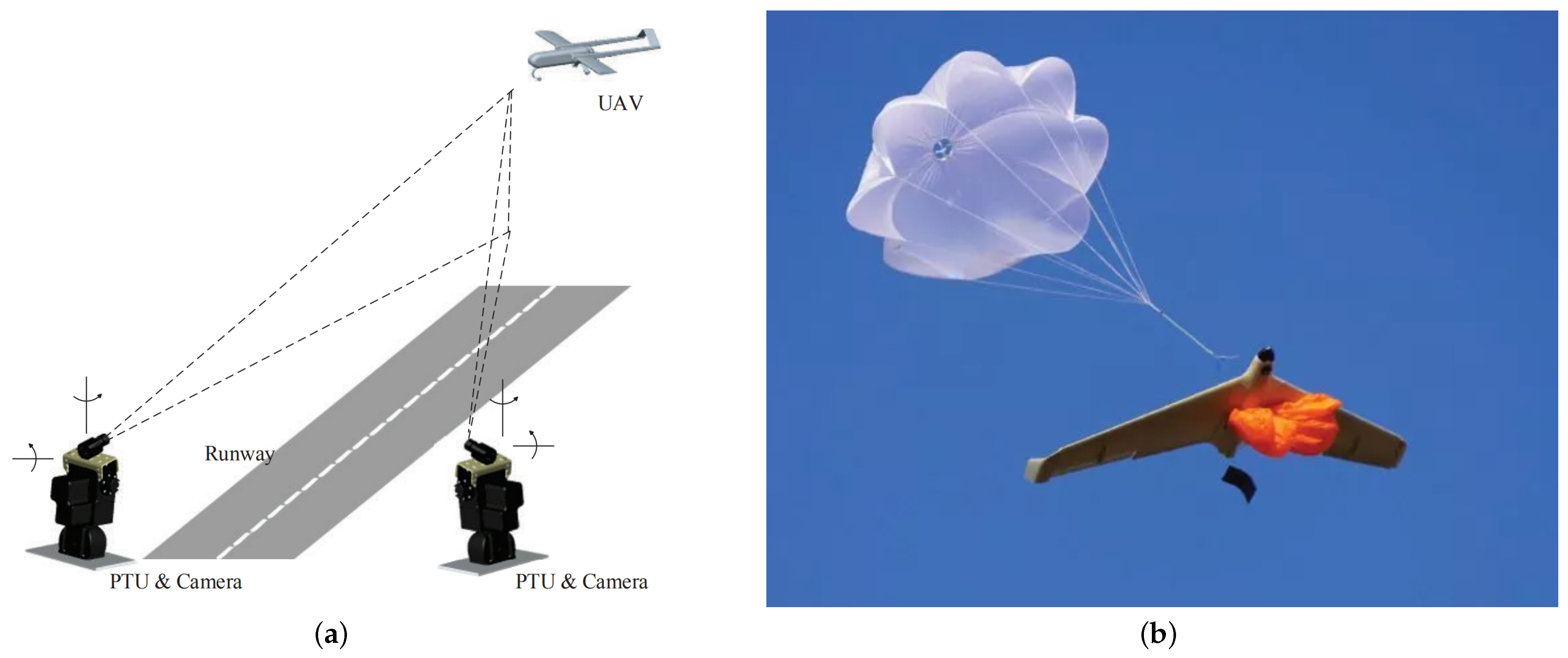

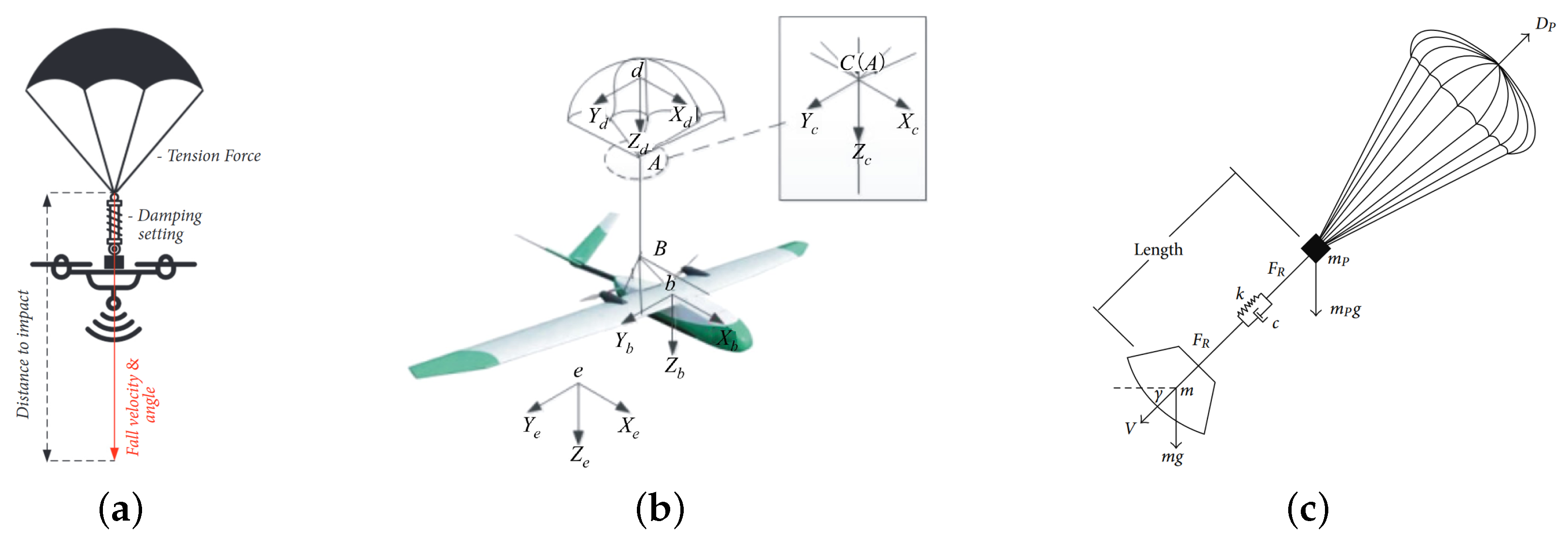
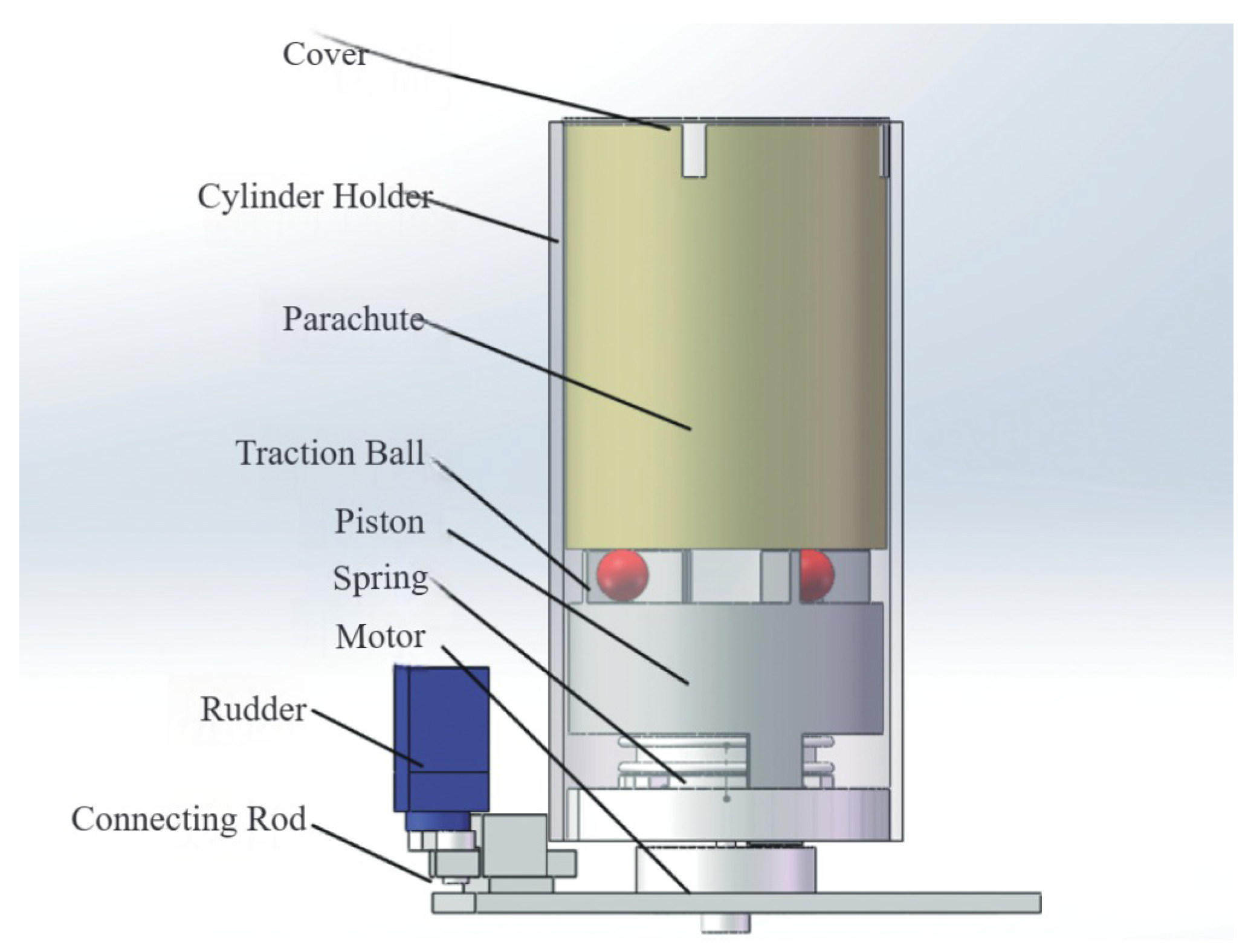


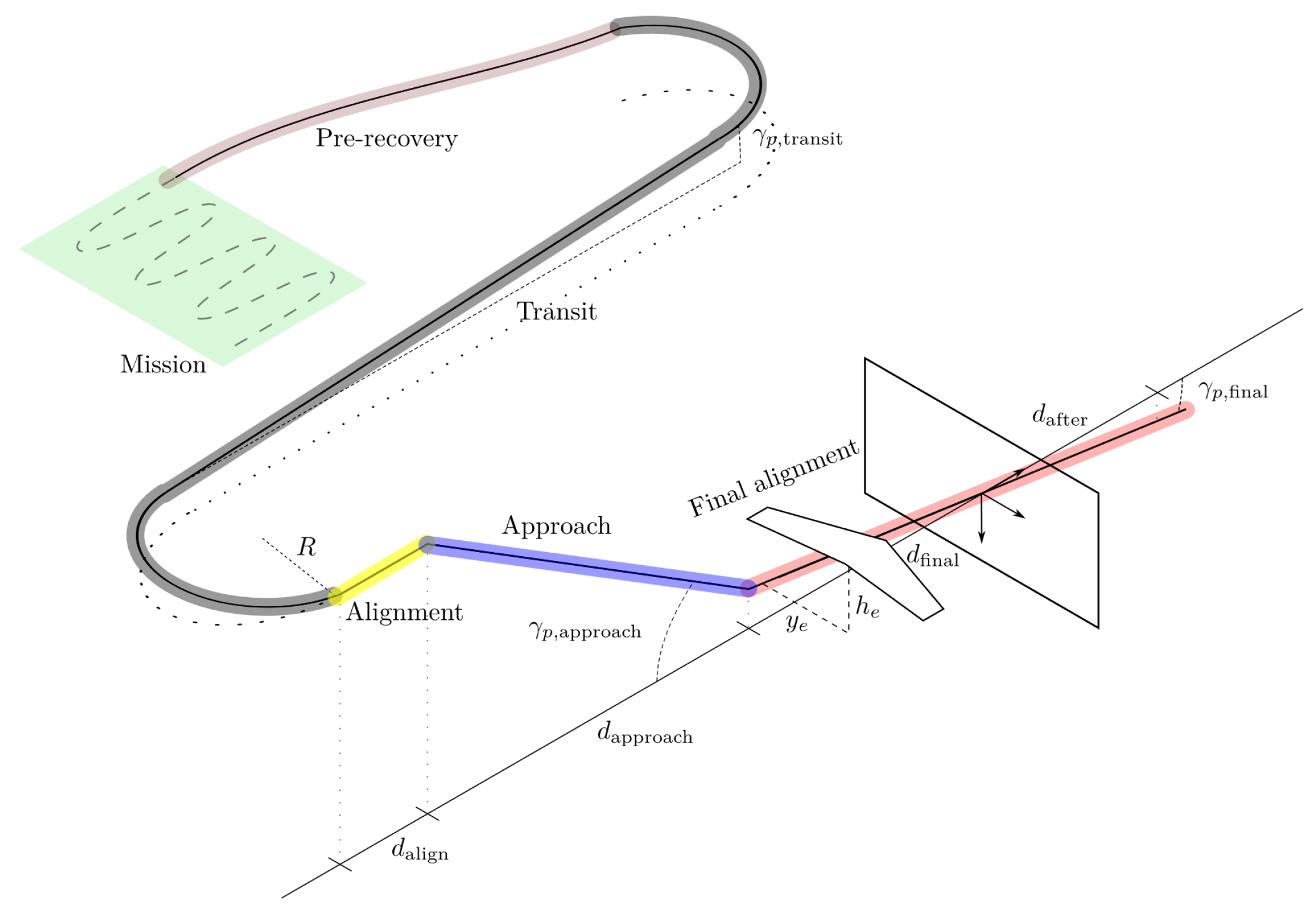

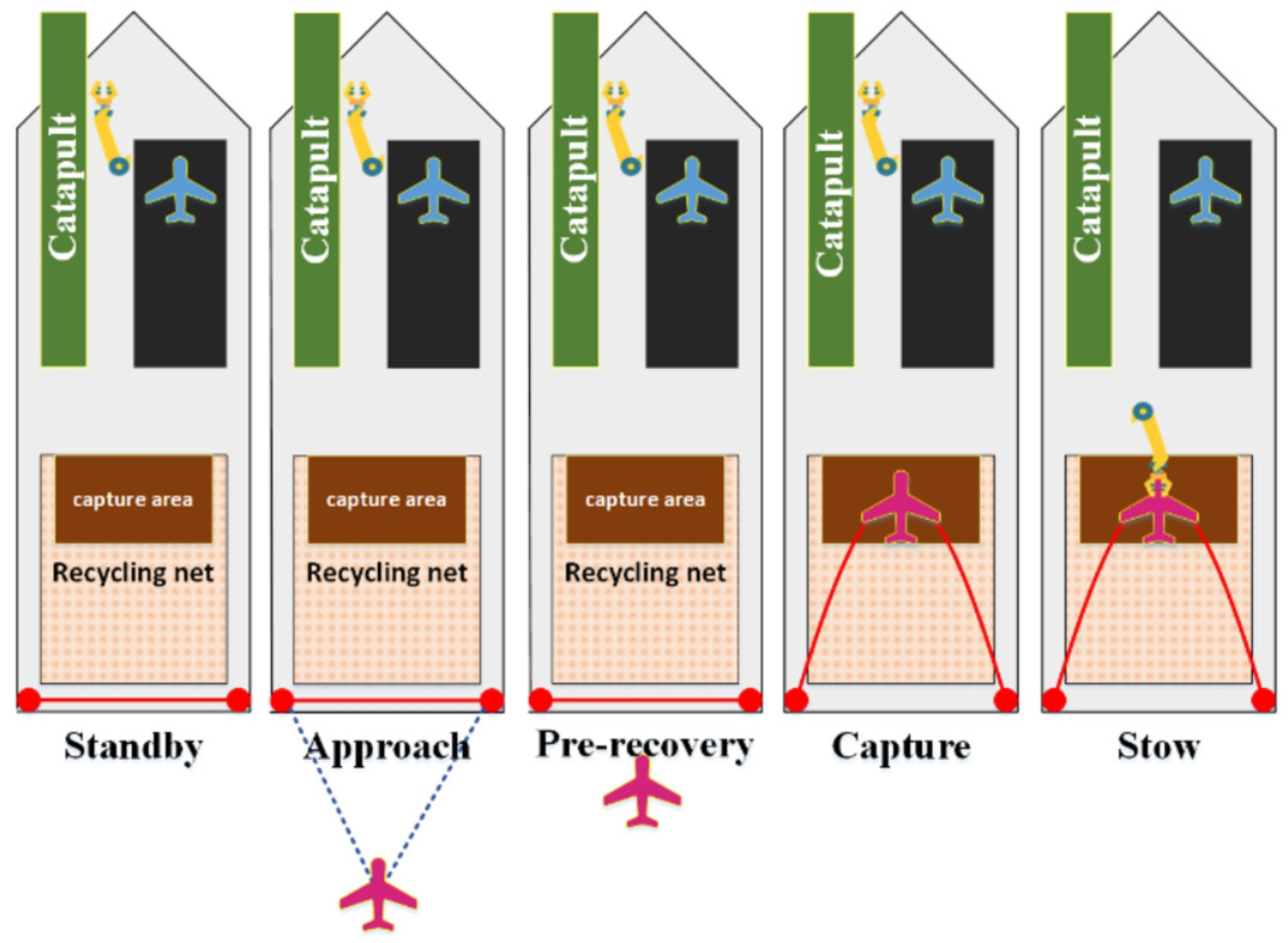


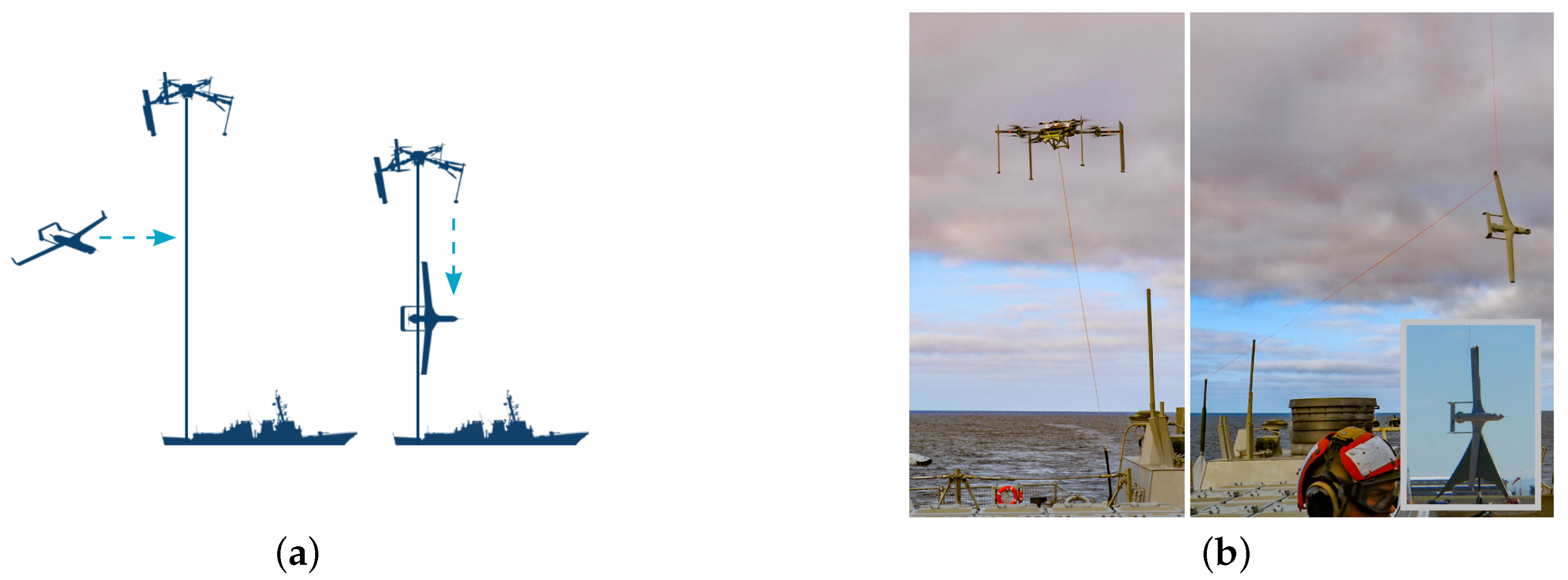
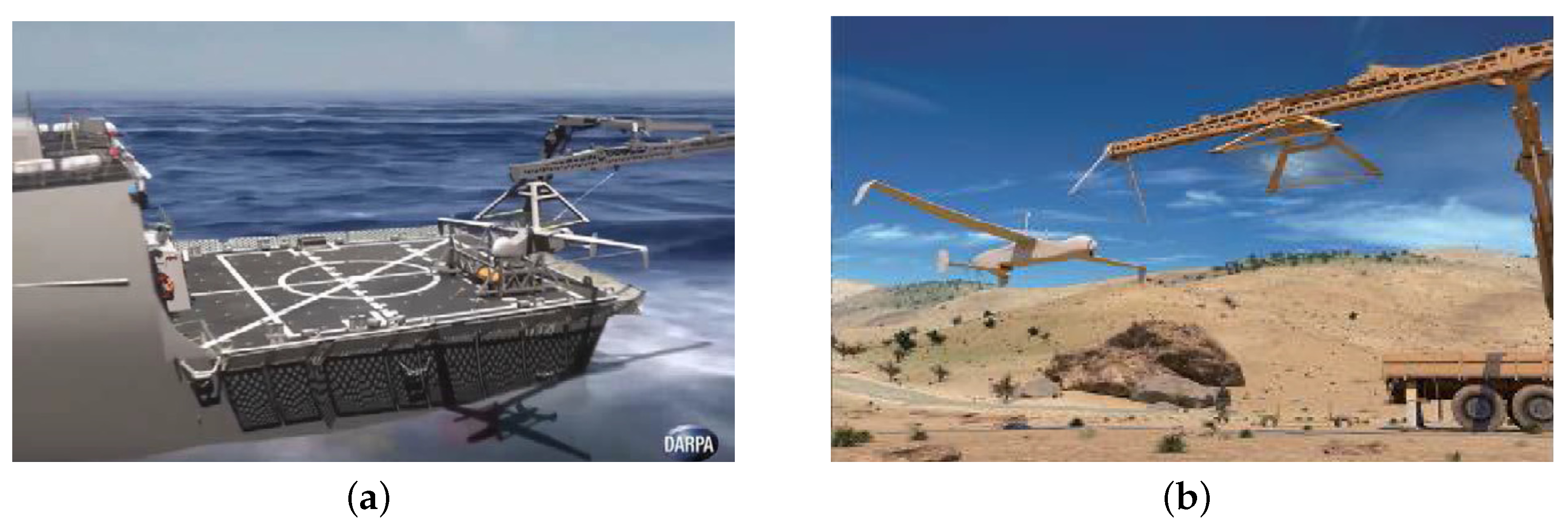
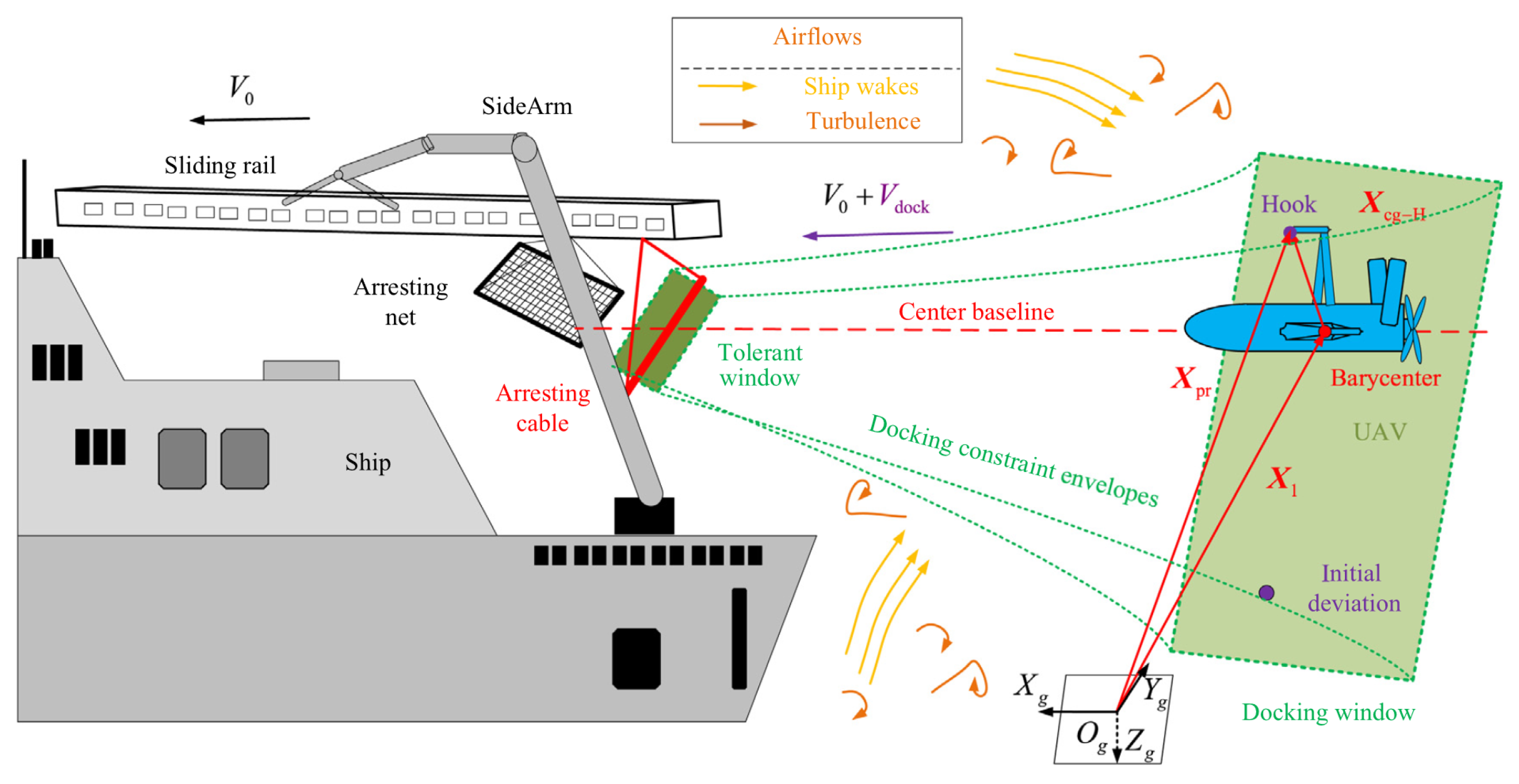
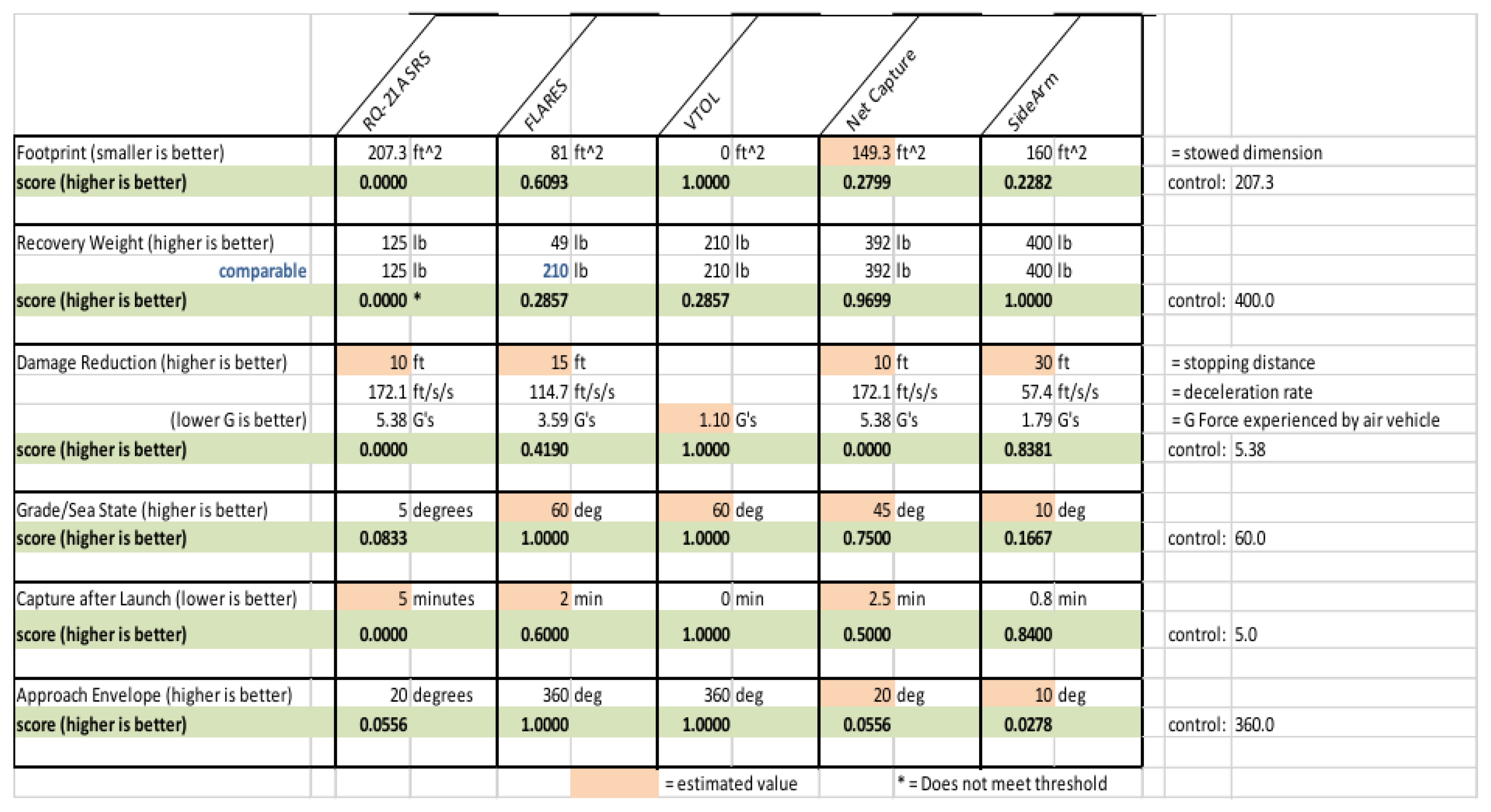

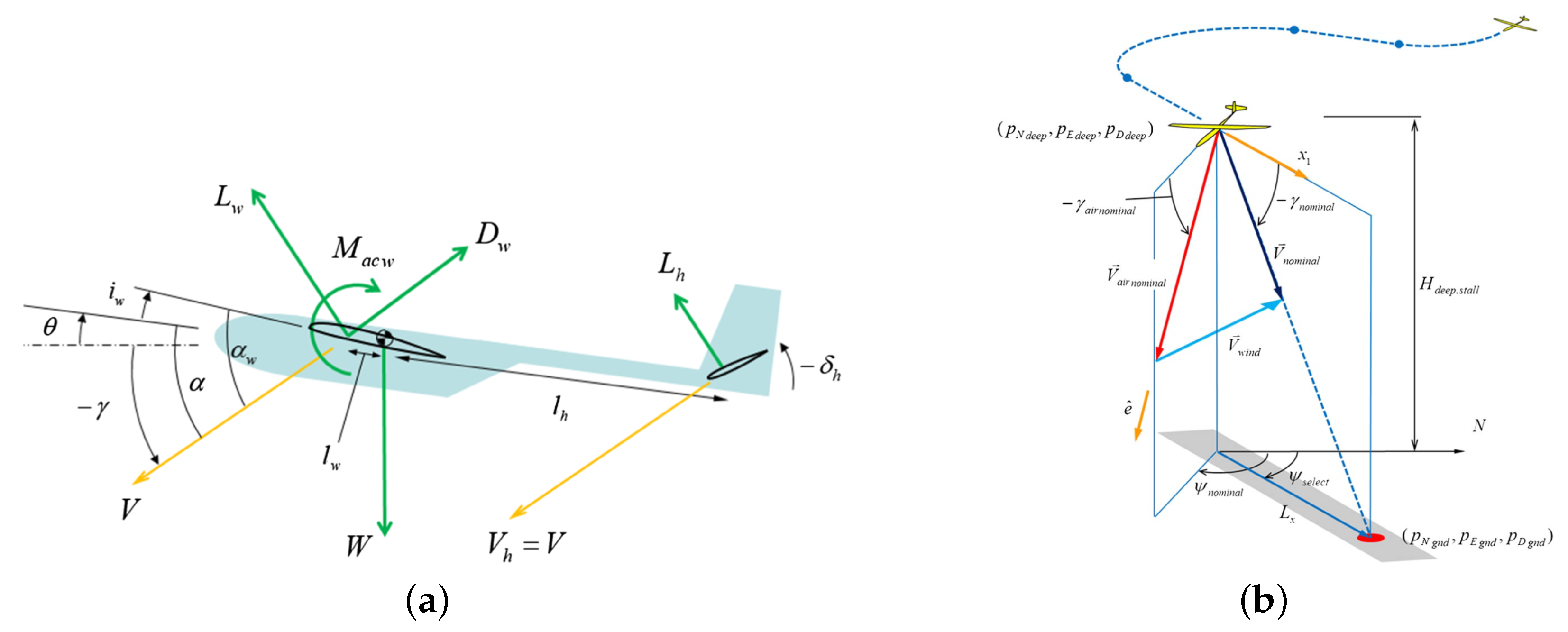

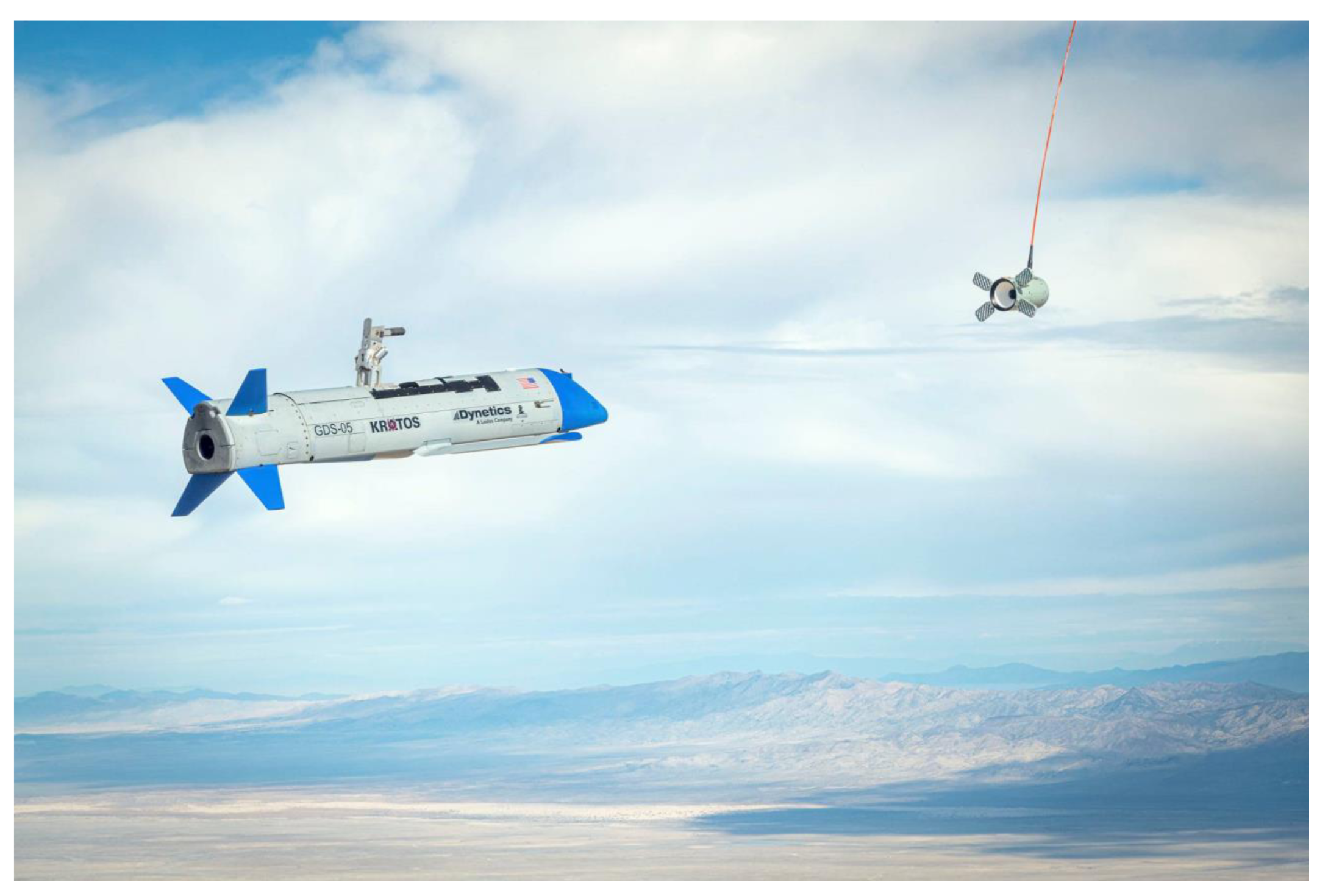

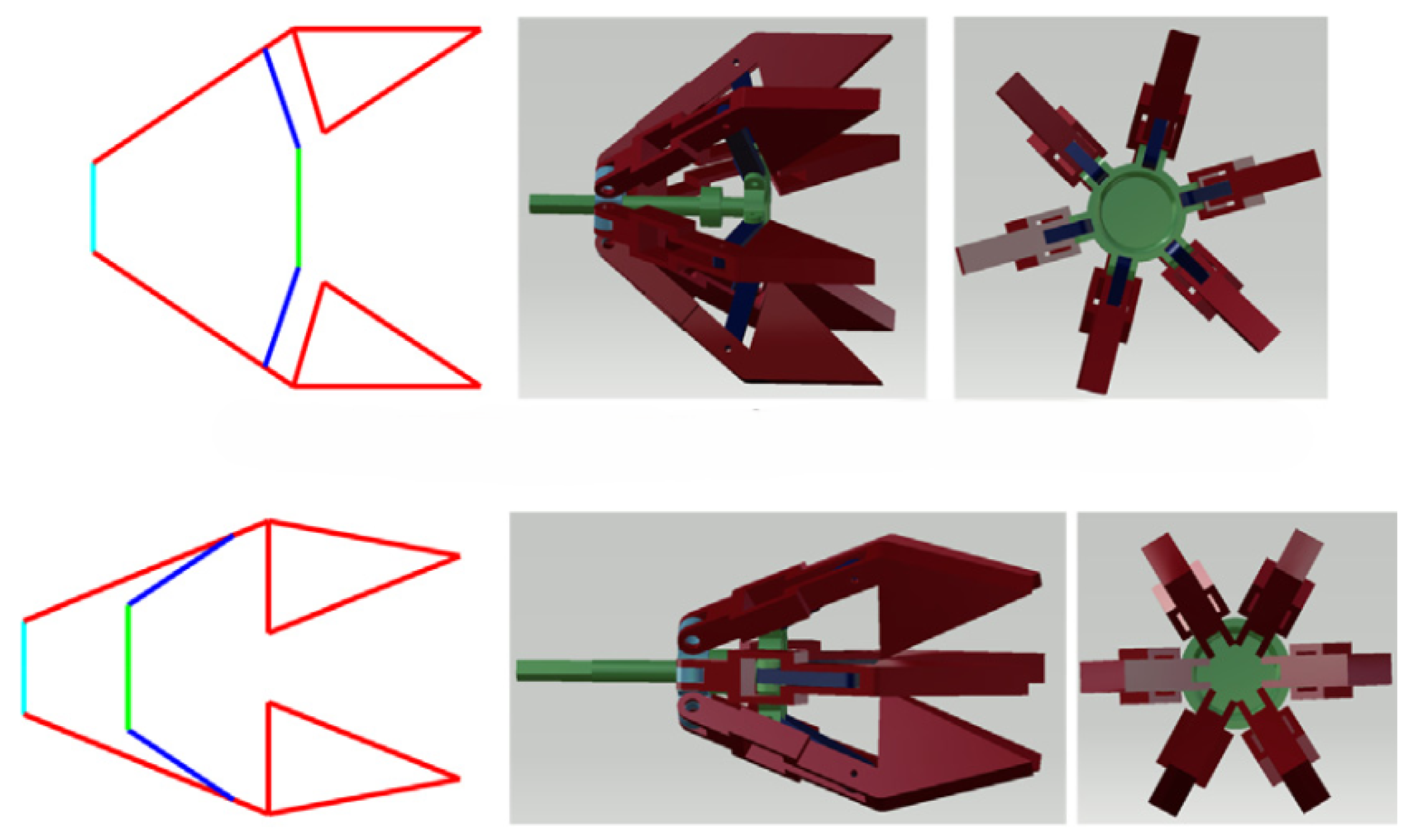
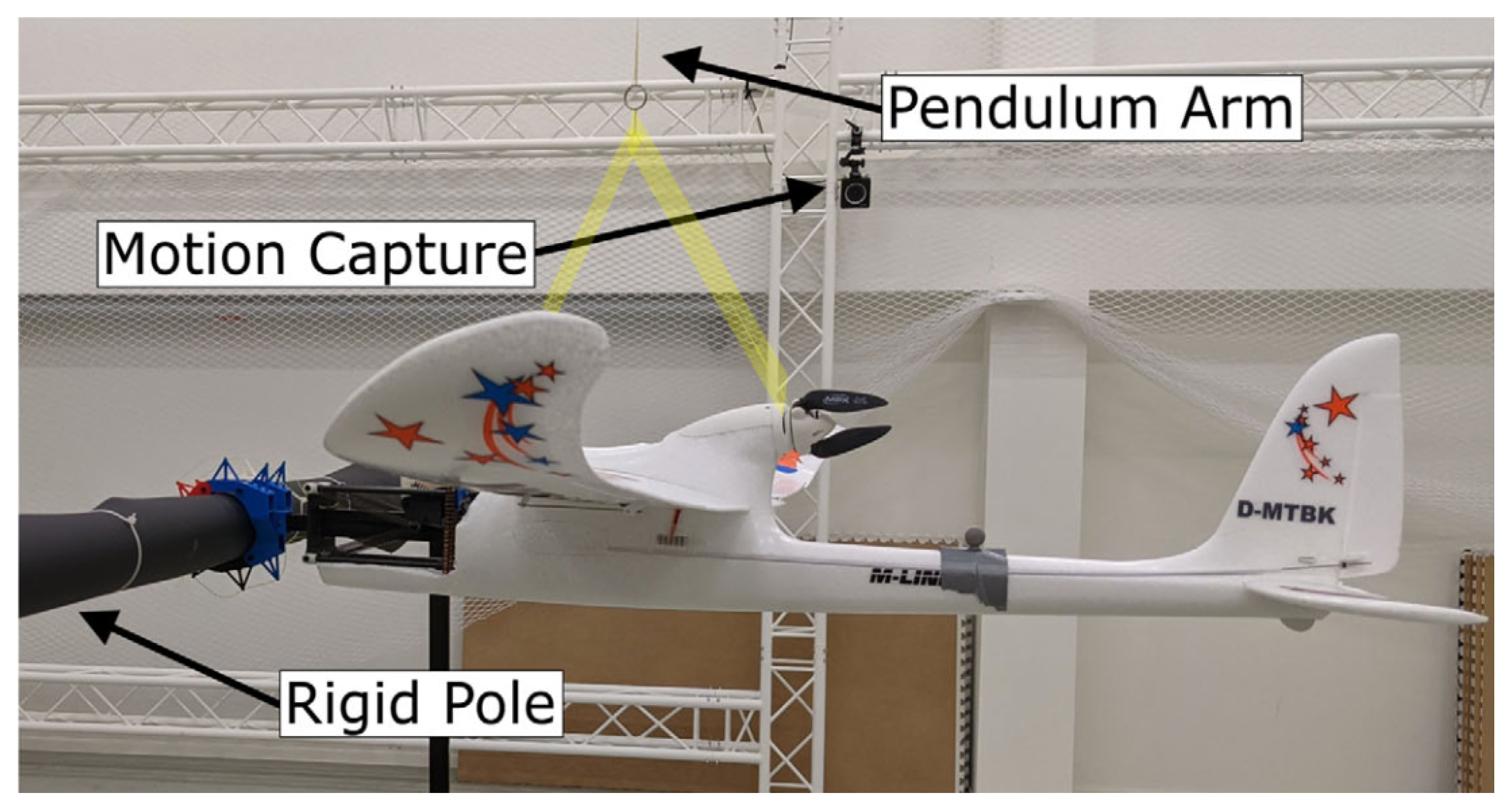
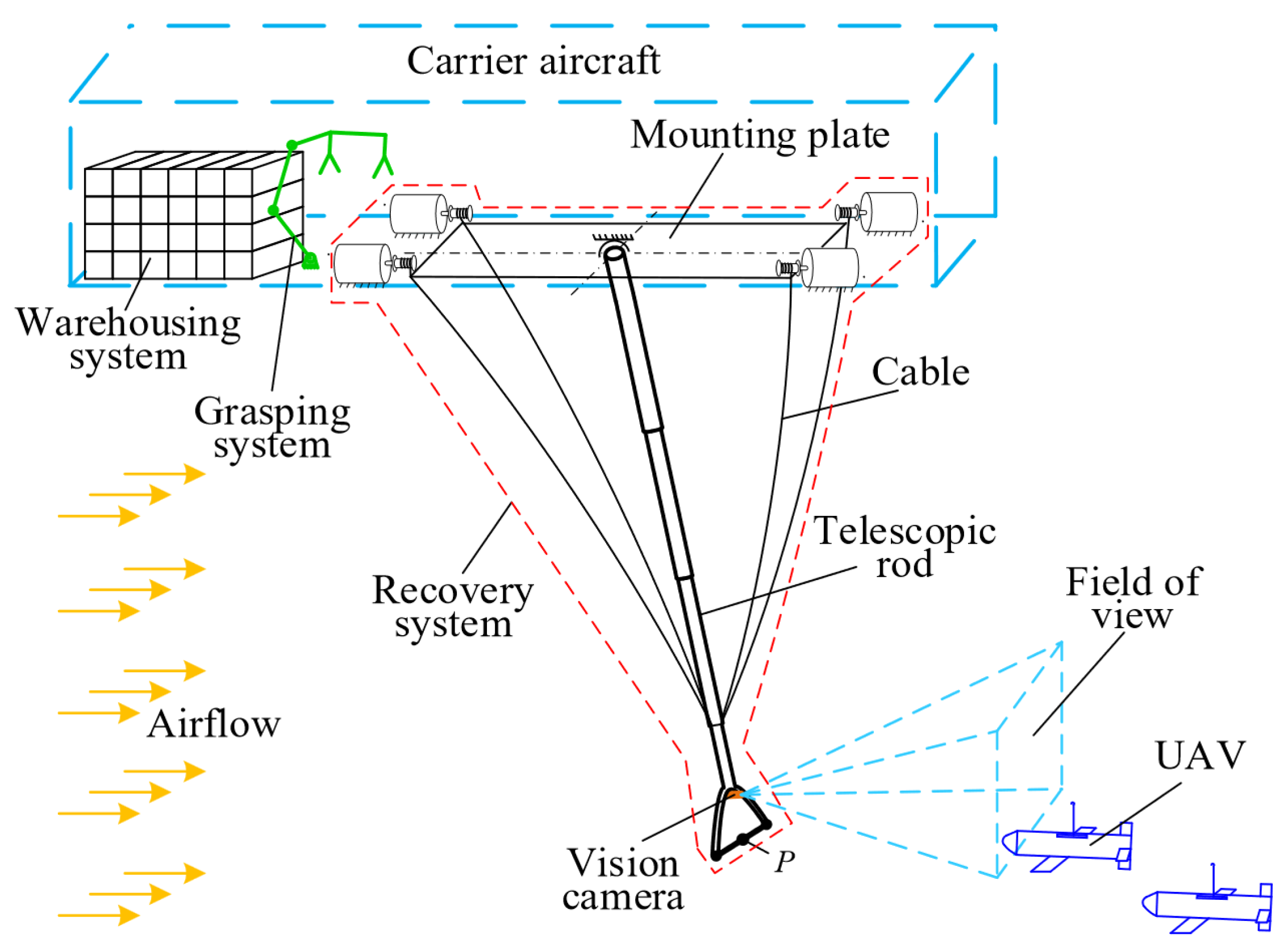

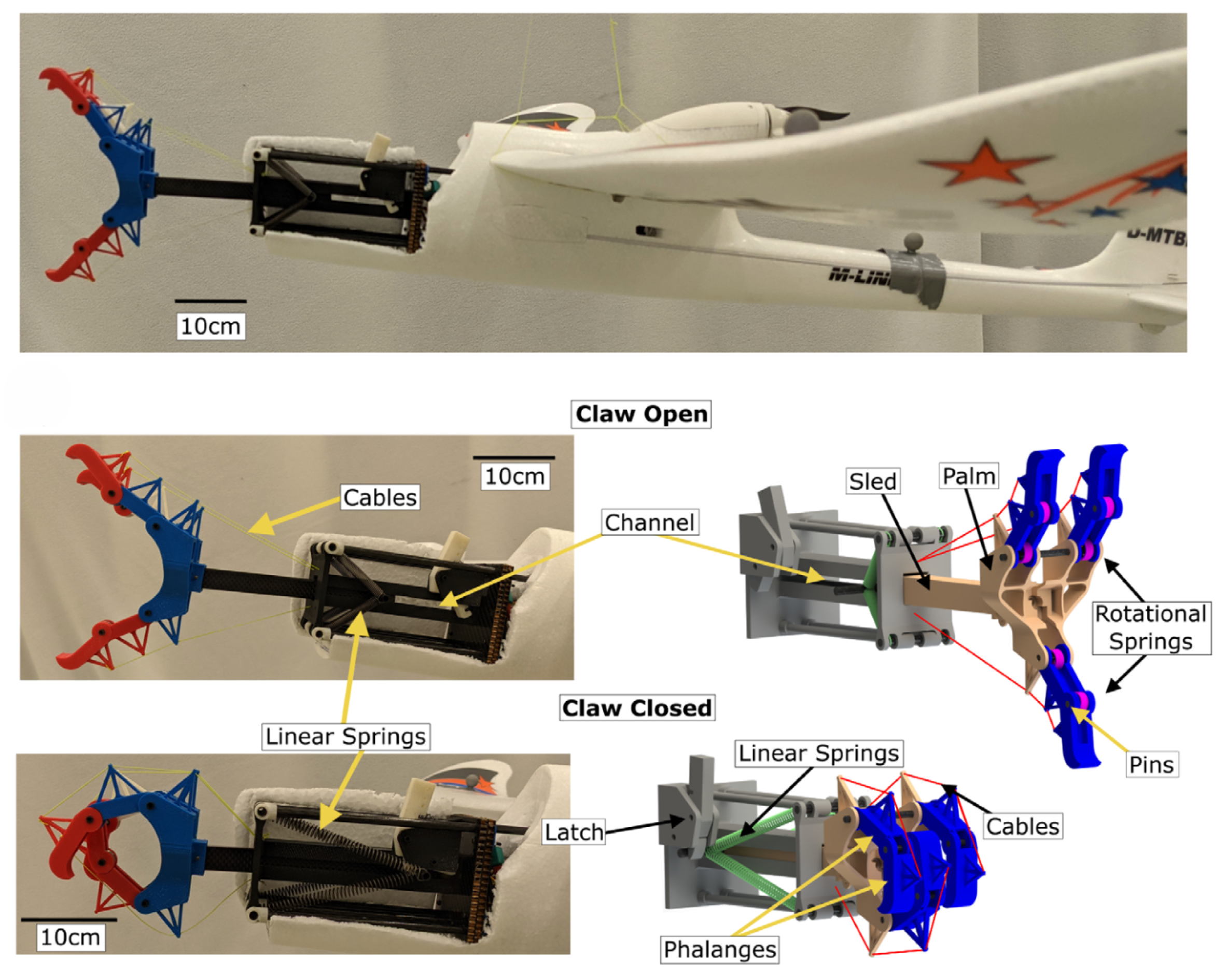





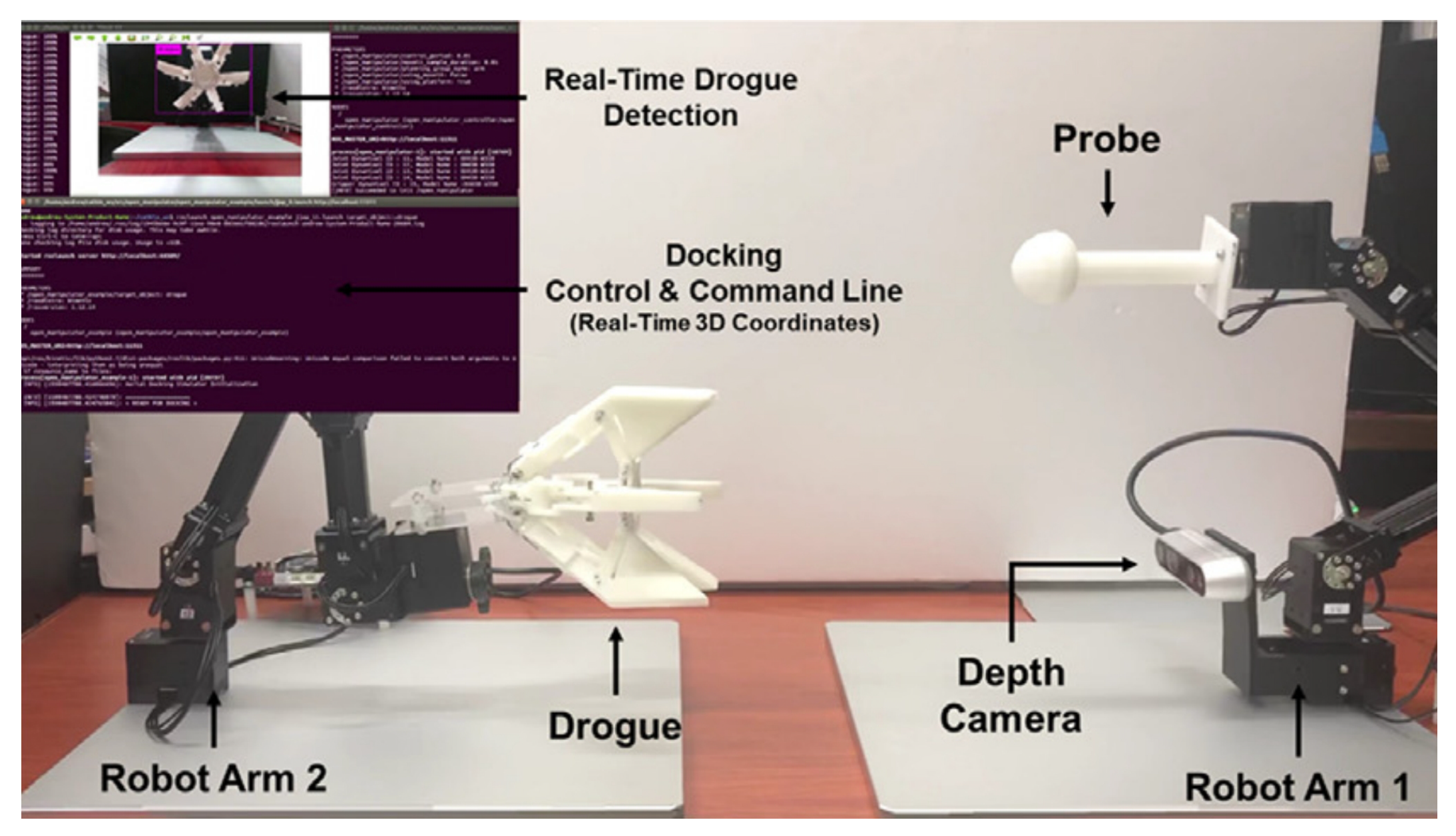
| Criteria | Data |
|---|---|
| Scientific Database | Google Scholar, IEEE Xplore, Engineering Village, Science Direct, manual search |
| Publication Period | From 2001 to July 2024 |
| Keywords | (“aerial” OR “fixed-wing UAV” OR “survey” OR “review”) AND (“autonomous recovery” OR “recovery”) |
| Recovery Methods | Applicable Scene | Complexity of Recovery Device | Recommended Engine Location | Special Requirements for Recovery | Key References |
|---|---|---|---|---|---|
| Parachute recovery | ♢ Land | Less complex | Front and rear | The landing area should be free from obstacles. | [21,22,23,24,25,26,27,28,29,30,31,32,33,34] |
| Net recovery | ♢ Land ♢ Vehicle-mounted ♢ Shipborne | Less complex | Rear | The recovery direction is consistent with the deployment direction of the network. | [35,36,37,38,39,40,41] |
| Rope capture recovery | ♢ Land | Complex | Front and rear | Horizontal rope: The recovery direction is consistent with the rope direction. | [42,43,44,45,46,47,48,49,50,51,52,53] |
| ♢ Shipborne | Vertical rope: The recovery direction can be determined according to the surrounding environment. | ||||
| SideArm recovery | ♢ Land ♢ Shipborne | Complex | Rear | The recovery direction follows the SideArm deployment direction. | [54,55,56,57,58,59] |
| Deep stall recovery | ♢ Land ♢ Shipborne | Simple | Front and rear | The recovery direction is determined by the wind direction and approach route. | [60,61,62,63,64,65,66,67,68,69,70,71] |
| Towed drogue docking recovery | ♢ Airborne | Complex | Rear | Strictly follow the traction drogue position for docking recovery. | [72,73,74,75,76,77,78,79,80,81,82,83] |
| Robotic arm recovery | ♢ Shipborne | Complex | Front and rear | Passive: Strictly follow the direction required by the Robotic arm deployment. | [84,85,86,87,88,89,90,91] |
| ♢ Airborne | Active: Determined according to the environment where it can be grasped and recovered. |
| Recovery Methods | Applicable Weight Range | UAV’s Modification | Fully Automatic Recovery Efficiency | Potential Risk of Damage | Technical Complexity |
|---|---|---|---|---|---|
| Parachute recovery | ♢ Micro ♢ Mini ♢ Small ♢ Medium | Complex | Relatively high (but needs to be retrieved manually) | Low | Low |
| Net recovery | ♢ Micro ♢ Mini ♢ Small ♢ Medium | No modification requirement | Relatively high (but needs to be removed manually) | High | Medium |
| Rope capture recovery | ♢ Micro ♢ Mini ♢ Small | Complex | Relatively high (but needs to be removed manually or with a robotic arm) | Low | Medium |
| SideArm recovery | ♢ Small ♢ Medium | Complex | High | Low | High |
| Deep stall recovery | ♢ Micro ♢ Mini ♢ Small | Simple | High | Low | High |
| Towed drogue docking recovery | ♢ Small ♢ Medium ♢ Large | Complex | High | Low | High |
| Robotic arm recovery | ♢ Mini ♢ Small ♢ Medium | Complex | Relatively high (difficult to achieve automation) | High | High |
| Control Algorithm | Recovery Type | Complexity | Difficulty of Parameter Adjustment | Robustness | Requirements for UAV Dynamics Models | Key References |
|---|---|---|---|---|---|---|
| Classical control | ♢ Parachute recovery ♢ Net recovery | Simple | Simple | Poor | Average | [35,36,72,78] |
| Modern control | ♢ Net recovery ♢ Rope recovery ♢ SideArm recovery | Complex | Average | Better | High | [39,77] |
| Intelligent control | ♢ Rope recovery ♢ Towed drogue docking recovery ♢ Robotic arm recovery | Average | Extremely difficult | Average | Low | [46,58,76] |
| Predictive control | ♢ Deep stall recovery ♢ Towed drogue docking recovery | Highly complex | Difficult | Excellent | Extremely high | [61,62] |
| Sensor | Information Type | Advantage | Disadvantage | Applicable Scenario | Key References |
|---|---|---|---|---|---|
| GNSS | ♢ Position | Low cost and high positioning accuracy based on RTK technology | RTK positioning requires the deployment of ground base stations | ♢ Applicable in all scenarios | [37,38,39,40,48,63,78,82,98] |
| Visible light camera | ♢ Color | Strong imaging capability and good dynamic characteristics | Easily affected by lighting and requires certain target detection algorithms | ♢ Airborne recovery ♢ Ship recovery | [73,74,82,100] |
| IR camera | ♢ Radiation | Radiation, good anti-interference ability | Beacons and develop feature extraction algorithms | ♢ Airborne recovery ♢ Ship recovery | [45,101] |
| Depth camera | ♢ Color ♢ Depth | Acquire image and depth information simultaneously | Short effective distance | ♢ Airborne recovery | [83,84,84] |
Disclaimer/Publisher’s Note: The statements, opinions and data contained in all publications are solely those of the individual author(s) and contributor(s) and not of MDPI and/or the editor(s). MDPI and/or the editor(s) disclaim responsibility for any injury to people or property resulting from any ideas, methods, instructions or products referred to in the content. |
© 2024 by the authors. Licensee MDPI, Basel, Switzerland. This article is an open access article distributed under the terms and conditions of the Creative Commons Attribution (CC BY) license (https://creativecommons.org/licenses/by/4.0/).
Share and Cite
Liu, Y.; Wang, Y.; Li, H.; Ai, J. Runway-Free Recovery Methods for Fixed-Wing UAVs: A Comprehensive Review. Drones 2024, 8, 463. https://doi.org/10.3390/drones8090463
Liu Y, Wang Y, Li H, Ai J. Runway-Free Recovery Methods for Fixed-Wing UAVs: A Comprehensive Review. Drones. 2024; 8(9):463. https://doi.org/10.3390/drones8090463
Chicago/Turabian StyleLiu, Yunxiao, Yiming Wang, Han Li, and Jianliang Ai. 2024. "Runway-Free Recovery Methods for Fixed-Wing UAVs: A Comprehensive Review" Drones 8, no. 9: 463. https://doi.org/10.3390/drones8090463
APA StyleLiu, Y., Wang, Y., Li, H., & Ai, J. (2024). Runway-Free Recovery Methods for Fixed-Wing UAVs: A Comprehensive Review. Drones, 8(9), 463. https://doi.org/10.3390/drones8090463





